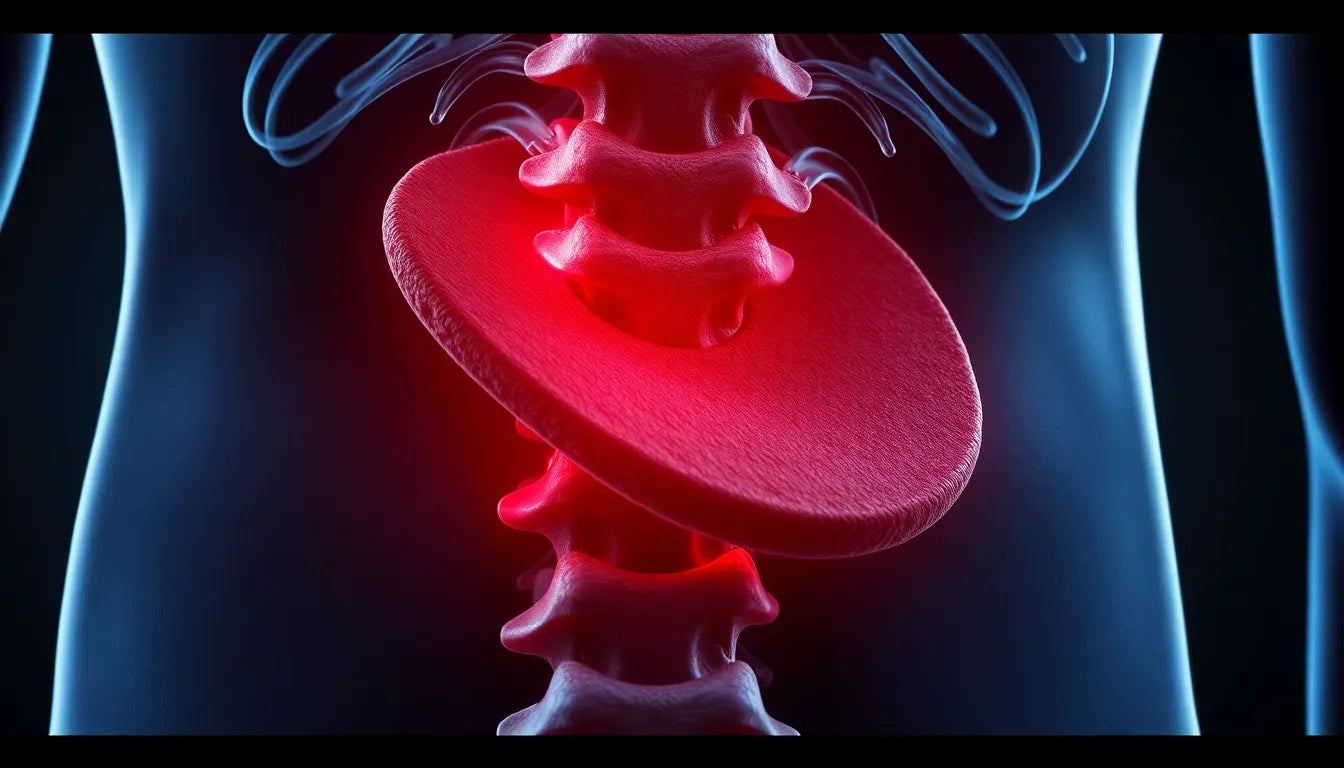Understanding how you get a herniated disc is crucial in preventing and managing this common spinal condition. A herniated disc occurs when the soft, jelly-like center of a spinal disc pushes through a crack in its tougher exterior. This can lead to pain, numbness, or weakness in an arm or leg, depending on the location of the herniation. Recognizing the causes of this condition is key to avoiding the discomfort and limitations it can impose on daily life.
Common misconceptions about herniated discs
One of the most widespread myths about herniated discs is that they are solely the result of heavy lifting or sudden injury. While improper lifting techniques and acute injuries can indeed lead to a herniated disc, they are not the only culprits. Many people are surprised to learn that age-related degeneration and repetitive stress are significant contributors to this condition. This misunderstanding can lead to neglecting other important factors that could be addressed to prevent disc herniation.
Another misconception is that herniated discs are a condition exclusive to older adults. While aging does increase the risk of disc degeneration, younger individuals are not immune. Lifestyle choices, such as smoking and maintaining a sedentary lifestyle, can also significantly increase the likelihood of experiencing a herniated disc, regardless of age.
Why understanding herniated discs matters
Herniated discs are more common than many realize, affecting a significant portion of the population at some point in their lives. The impact on daily activities can be profound, as the pain and discomfort often limit mobility and reduce quality of life. Recognizing both the genetic and lifestyle factors that contribute to the development of herniated discs is essential for effective prevention and management.
By gaining a deeper understanding of the causes behind herniated discs, individuals can take proactive steps to protect their spinal health. This knowledge empowers people to make informed decisions about their daily habits and lifestyle choices, ultimately reducing the risk of developing this painful condition. In the following sections, we will explore the biological, mechanical, genetic, and environmental factors that play a role in the development of herniated discs, providing a comprehensive look at how to minimize your risk.
Biological and mechanical causes of herniated discs
Understanding the biological and mechanical causes of herniated discs is crucial for both prevention and effective management. One of the primary biological factors is age-related degeneration. As we age, the spinal discs naturally undergo wear and tear. This degeneration is a normal part of aging, but it can lead to the weakening of the discs, making them more susceptible to herniation. The outer layer of the disc, known as the annulus fibrosus, can develop small tears over time, allowing the inner gel-like substance to protrude, resulting in a herniated disc.
Mechanical stress and damage also play significant roles in the development of herniated discs. Improper lifting techniques, for instance, can exert excessive pressure on the spine, causing tears in the outer ring of the disc. This is why it's crucial to use proper form when lifting heavy objects, bending at the knees rather than the waist, and keeping the load close to the body. Additionally, repetitive motions and excessive strain on the spine, whether from occupational activities or sports, can exacerbate the risk of disc herniation. These mechanical factors underscore the importance of maintaining good posture and using ergonomic tools in daily activities.
Genetic and environmental influences on herniated discs
Genetic predisposition is another key factor in the development of herniated discs. Research has shown that hereditary factors can significantly influence an individual's likelihood of experiencing this condition. Studies indicate that if a close family member has suffered from a herniated disc, the risk may be higher for other family members due to shared genetic traits. This genetic predisposition can affect the structural integrity of the spinal discs, making them more prone to degeneration and herniation.
Environmental factors also contribute to the risk of developing herniated discs. Lifestyle choices such as smoking, obesity, and a sedentary lifestyle can weaken the spinal discs over time. Smoking, in particular, reduces oxygen supply to the spinal discs, impairing their ability to repair and maintain themselves. Obesity places additional stress on the spine, increasing the likelihood of disc herniation. Similarly, a sedentary lifestyle can lead to weakened core muscles, which are essential for supporting the spine and maintaining proper posture. Addressing these environmental factors through lifestyle changes can significantly reduce the risk of herniated discs.
Risk factors and prevention strategies
Identifying risk factors is a crucial step in preventing herniated discs. Age, gender, family history, and occupation are key risk factors to consider. For example, individuals over 30 are more prone to herniated discs due to natural degeneration. Men are slightly more likely to experience herniated discs than women, possibly due to differences in physical activity levels and occupational hazards. Those with a family history of herniated discs should be particularly vigilant about maintaining spinal health.
Preventive measures are essential for reducing the risk of herniated discs. Regular exercise is one of the most effective ways to maintain spinal health, as it strengthens the core muscles that support the spine. Engaging in activities such as swimming, walking, and yoga can help improve flexibility and reduce the likelihood of disc herniation. Proper lifting techniques and ergonomic workplace setups are also crucial in preventing unnecessary strain on the spine. Additionally, quitting smoking and maintaining a healthy weight can significantly contribute to spinal health, reducing the risk of herniated discs.
Lifestyle and occupational risks associated with herniated discs
Understanding how lifestyle and occupational factors contribute to herniated discs is essential for prevention. Certain professions, particularly those involving heavy lifting, repetitive motions, or prolonged periods of sitting, can significantly increase the risk of developing a herniated disc. For instance, jobs that require frequent bending, twisting, or lifting, such as construction work or nursing, put additional strain on the spine. To mitigate these risks, it's crucial to implement ergonomic adjustments in the workplace, such as using lifting aids, maintaining proper posture, and taking regular breaks to stretch and move.
Daily habits also play a critical role in spinal health. Poor posture, whether sitting at a desk or standing for long periods, can lead to undue stress on the spinal discs. Strengthening core muscles through exercises like planks or Pilates can provide better support for the spine, reducing the risk of herniation. Incorporating spinal-friendly activities into daily routines, such as yoga or swimming, can enhance flexibility and promote overall spinal health.
Conclusion: A holistic approach to preventing herniated discs
Preventing herniated discs requires a balanced approach that considers both genetic predispositions and lifestyle factors. While some risk factors, like age and genetics, are beyond our control, many lifestyle choices can be modified to support spinal health. By adopting healthier habits, such as engaging in regular exercise, maintaining a healthy weight, and practicing proper lifting techniques, individuals can significantly reduce their risk of developing herniated discs. A proactive approach to spinal health not only helps in prevention but also enhances overall well-being.
Frequently Asked Questions
What are the symptoms of a herniated disc?
A herniated disc often presents symptoms such as pain, numbness, or weakness in the affected area. If the herniation occurs in the lower back, it may cause pain that radiates down the leg, commonly known as sciatica. In the neck, it can lead to pain in the shoulder or arm. It's important to note that some people with herniated discs may not experience any symptoms at all.
Can herniated discs heal on their own?
In many cases, herniated discs can improve over time with conservative treatment. The body's natural healing processes can reduce the size of the herniation and alleviate symptoms. However, if pain persists or worsens, it is crucial to seek medical advice. Treatments such as physical therapy, medications, and in some cases, surgery, may be necessary.
How is a herniated disc diagnosed?
Diagnosis of a herniated disc typically involves a physical examination and a review of the patient's medical history. Doctors may also order imaging tests, such as an MRI or CT scan, to confirm the diagnosis and determine the extent of the herniation. These tests help in planning the most effective treatment strategy.
What treatment options are available for herniated discs?
Treatment for herniated discs often begins with conservative approaches, such as physical therapy, exercises, and pain management through medications. In cases where these methods are ineffective, or if the symptoms are severe, surgical options may be considered. Surgery typically involves removing the herniated portion of the disc to relieve pressure on the nerves.
Closing thoughts
Understanding the causes and risk factors of herniated discs is vital for effective prevention and management. By making informed lifestyle choices and seeking professional advice when needed, individuals can take proactive steps to protect their spinal health and improve their quality of life. If you suspect you have a herniated disc, consult a healthcare professional for an accurate diagnosis and appropriate treatment plan.
Sources
- American Academy of Orthopaedic Surgeons. "Herniated Disk." OrthoInfo.
- Doe, J. et al. (2018). "Genetic and Environmental Factors in Disc Herniation." PubMed Central.
- American Association of Neurological Surgeons. "Herniated Disc."
- Riverhills Neuroscience. "Herniated Disc Causes and Risk Factors."
- Johns Hopkins Medicine. "Herniated Disk."
- Stanford Health Care. "Herniated Disc Overview."


















